The Manatee Nebula (Westerhout 50) is an extended supernova remnant located approximately 18,000 light years away in the constellation Aquila (the Eagle). It is associated with the microquasar SS 433. Both are likely remnants of the same supernova event that occurred around 20,000 years ago.
The Manatee Nebula is about 650 by 350 light-years in size (corresponding to 3.3 by 6.2 quadrillion kilometres). It extends 2 degrees east to west and 1 degree north to south. With an apparent size equivalent to that of four full Moons, the nebula is one of the largest supernova remnants known in the Milky Way, along with Diprotodon (3°.33 x 3°.23), HBH 3 (1°.5 x 2°.0), Hoinga (4°.4), and the Vela Supernova Remnant (8°).
Westerhout 50 was named the Manatee Nebula by the National Radio Astronomy Observatory (NRAO) at the Florida Manatee Festival in Crystal River, Florida, in January 2013, while unveiling an image of the nebula captured by the Very Large Array (VLA) radio telescope. In radio wavelengths, the nebula looks like a giant sea cow in the sky.
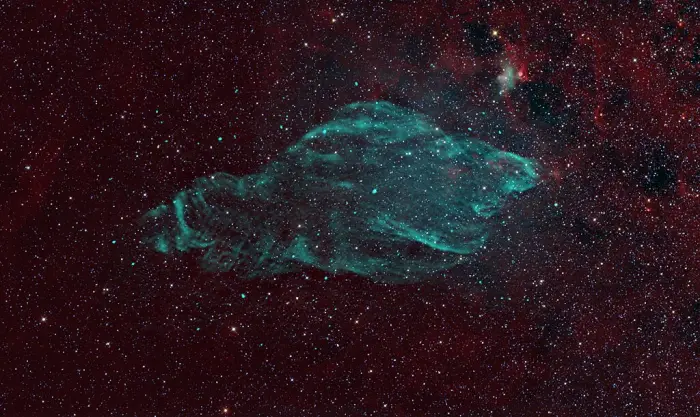
This enormous W50 cloud, visible only in radio waves, formed when a giant star, 18,000 light years away in the constellation of Aquila, went out as a supernova around twenty thousand years ago. The remaining black hole feeds on gas it collects from a very close companion star. Its gas disk and powerful magnetic field lines act like an enormous railroad system. It snags charged particles and channels them outward as powerful jets traveling at nearly the speed of light. This system shines brightly in both radio waves and X-rays and is known collectively as the SS433 microquasar. Over time, the microquasar’s wobbling jets have punched corkscrew bulges on either side of W50, seen here in this image from the Very Large Array (VLA). Credit: B. Saxton, (NRAO/AUI/NSF), K. Golap, M. Goss; NASA’s Wide Field Survey Explorer (WISE) (CC BY 3.0)
The supernova remnant has puzzled astronomers since its discovery in the mid-1970s. Even Arthur C. Clarke called it one of his “seven wonders of the universe.”
The supernova remnant consists of a central component about 1 degree across and two “ears” that extend to the northwest and southeast. At the centre of the nebula is the eclipsing X-ray binary system SS 433, which sends relativistic jets along the nebula’s major axis.
The Manatee Nebula formed when a massive star reached the end of its life and went out as a supernova. The material expelled by the supernova event forms the giant bubble best seen at radio wavelengths. Composed of gases ejected from the progenitor star, the Manatee is bounded by an expanding shock wave that sweeps up the surrounding interstellar material, making it part of the glowing nebula.
The high-mass X-ray binary system at the centre of the Manatee Nebula consists of a stellar-mass black hole and an A-type companion star. The system is at an advanced evolutionary stage. It was the first object to be identified as a microquasar. The two components have an orbital period of 13.082 days. They have an elliptical orbit with an eccentricity of 0.05 ± 0.01. In 2021, a team led by A. M. Cherepashchuk found evidence for orbital period increase of about 3 seconds per year.
Supernova remnants typically take around 30,000 years to slow down and for their expansion velocities to become similar to the velocities of the surrounding interstellar medium. Over the next 10,000 years, the Manatee Nebula will merge with and disappear into the surrounding space.
The core of the massive progenitor star of the Manatee Nebula is believed to have collapsed into a black hole that accretes gas from the close companion star. As the black hole tears material off the companion, the collected gas forms a disk that swirls around the black hole. The donor star is believed to be an evolved supergiant of the spectral type A7Ib.

ESA’s XMM-Newton has X-rayed this beautiful cosmic creature, known as the Manatee Nebula, pinning down the location of unusual particle acceleration in its ‘head’. The Manatee Nebula, or W50, is thought to be a large supernova remnant created when a giant star went out as a supernova around 30,000 years ago, flinging its shells of gases out across the sky. It is one of the largest such features known, spanning the equivalent size of four full Moons. Unusually for a supernova remnant, a black hole remains in its core. This central ‘microquasar’, known as SS 433, emits powerful jets of particles travelling at speeds close to a quarter the speed of light that punch through the gassy shells, creating the double-lobed shape. SS 433 is identified by the red dot in the middle of the image. The X-ray data acquired by XMM-Newton are represented in yellow (soft X-rays), magenta (medium energy X-rays) and cyan (hard X-ray emission), while red is radio and green optical wavelengths imaged by the Very Large Array and the Skinakas Observatory in Greece, respectively. NASA NuSTAR and Chandra data were also used for the study (not shown in this image). Credit: S. Safi-Harb et al (2022), ESA (CC BY-SA 3.0 IGO)
The accretion disk spirals into the primary component. It has an exceptionally high temperature, and the heating causes it to emit powerful X-rays and two opposing jets perpendicular to the disk. The magnetic fields of the black hole and the accretion disk channel the powerful jets of charged particles that travel at velocities 26% of the speed of light. The material in the jets is mostly hot hydrogen.
The jets from SS 433 are distorting the shell of the cosmic Manatee, piercing through its expanding gases and producing the nebula’s elongated shape. They punched bulges outward on either side of the expanding remnant and are responsible for the nebula’s double-lobed morphology.
The gravity of the companion star causes the disk of accreted material to slowly wobble. As a result, the direction of the jets changes and they start to form giant spiral similar to a corkscrew. The jets precess with a period of around 164 days.
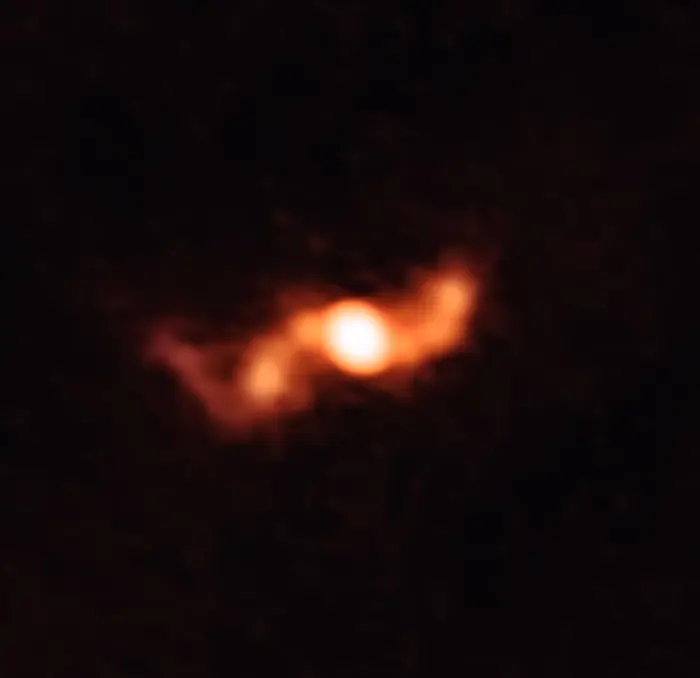
This is SS 433, a microquasar first discovered forty years ago and located about 18 000 light-years away in the constellation of Aquila (The Eagle). This image, captured for the very first time at submillimeter wavelengths by the Atacama Large Millimeter/submillimeter Array (ALMA), is special because it shows the jets emitted by a hot, swirling disc of material encircling the black hole at SS 433’s centre. Owing to its relative proximity, SS 433 is a particularly useful object for researchers looking to learn more about microquasars and the jets they emit.
The corkscrew shape visible here is created by a phenomenon known as precession; as they move outwards through space, these two jets are slowly tumbling around an axis in a similar way to the motion of a gyroscope or a spinning top slowing down, the orientation of their rotational axes changing as they do so. The scale of this corkscrew is enormous, at 5000 times the size of the Solar System. Image credit: ALMA (ESO/NAOJ/NRAO)/K. Blundell (University of Oxford, UK), R. Laing, S. Lee & A. Richards, Ap J Letters (CC BY 4.0)
In 2014, observations with the National Science Foundation’s (NSF) Karl G. Jansky Very Large Array (VLA) captured the wispy structure and central star system of the celestial Manatee. The black hole and its companion appear bright in X-ray and radio wavelengths. The radio telescope showed the supernova remnant in green, silhouetted against the backdrop of stars captured by the Wide-Field Infrared Survey Explorer (WISE).
In 2022, observations with the NuSTAR X-ray space telescope, the XMM-Newton X-ray space observatory, and the Chandra X-ray Observatory detected hard non-thermal X-ray emission from a knotty region located up to 18 arcminutes east of SS 433, corresponding to a physical separation of up to 29 parsecs (95 light years). The knots mark the location of the acceleration sites within the Manatee’s jet.
The multi-wavelength analysis of the Manatee conducted by a team of astronomers led by Samar Safi-Harb of the University of Manitoba, Winnipeg, revealed that the head of the Manatee represents an acceleration zone and the onset of the eastern lobe. The hardest non-thermal X-ray emission was detected in the inner eastern lobe, peaking in the head region, while soft thermal X-ray emission dominates the termination shock in the radio “ear” region.
The nebula is a galactic PeVatron candidate, a site of cosmic ray acceleration in a jet source. PeVatrons are astrophysical objects – supernova remnants, pulsar wind nebulae, young open star clusters – that act as natural particle accelerators and are capable of accelerating cosmic rays to energies of 1 PeV (petaelectronvolt) or 1015 electron volts. These cosmic rays (high-energy particles, mostly protons) move through space at velocities close to the speed of light. Supernovae are known to be sources of cosmic rays.

Chandra image of SS 433 shows two high speed lobes of 50 million degree gas 5 trillion kilometers apart on opposite sides of a binary black hole system. As shown in the illustration (lower right), the binary system, which has a diameter several million times smaller than the distance between the lobes, consists of a massive star and a black hole with a disk of hot matter. Material is ejected from this disk in narrow jets that slowly wobble or precess around a circle (represented by blue circular arrow), from the sketched location of the jet at one end to the dotted white line at another. The detection of the hot gas lobes so far away from the central black hole came as a surprise since earlier observations by Chandra and the Hubble Space Telescope had indicated that gas was cooling as it expanded away from the vicinity of the black hole in narrow jets. This led scientists to predict that no hot gas would be found further than a few million kilometers from the black hole. This observation implies that the gas in the jets has been reheated, most likely by collisions between blobs of gas. Long-term optical monitoring observations have shown that matter is ejected every few minutes from the vicinity of the black hole in bullet-like gaseous blobs. The blobs apparently travel outward at about a quarter of the speed of light for several months without colliding until a faster blob rear-ends a slower one, precipitating a pileup that reheats the gas. Credit: NASA/CXC/U.Amsterdam/S.Migliari et al. (PD)
Facts
The Manatee Nebula is catalogued as Westerhout 50 in Dutch astronomer Gart Westerhout’s 1958 catalogue of radio sources. It was catalogued as a galactic supernova remnant (SNR G39.7-02.0) by Velusamy and Kundu in 1974 and van den Bergh in 1980.
Located in the western part of Aquila, the X-ray binary system SS 433 was discovered by American astronomer Larry Krumenaker on a glass plate while looking for stars with emission lines in 1975. Krumenaker named the object K16 and announced his discovery in Publications of the Astronomical Society of the Pacific. He found that the object had a H-alpha line three to four times wider than average.
SS 433 gets its name from the Stephenson-Sanduleak catalogue of stars with strong emission lines. The designation comes from the initials of Nicholas Sanduleak and Charles Bruce Stephenson, who included the system as the 433rd entry in their 1977 catalogue.
The system has the variable star designation V1343 Aquilae and is classified as an eclipsing binary. Its variability was first reported in 1979.
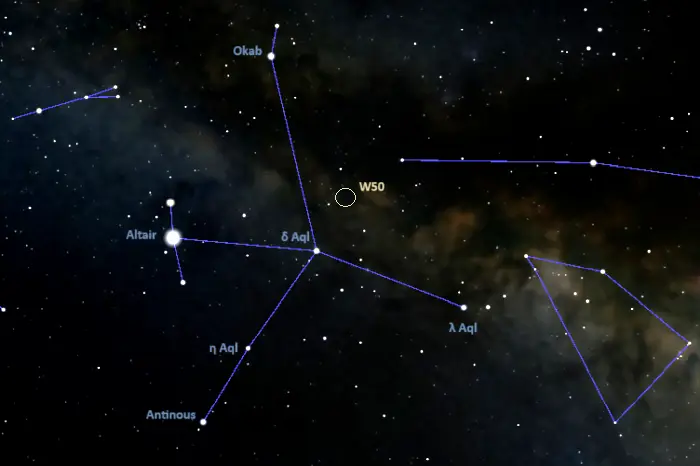
Location of the Manatee Nebula, image: Stellarium
Manatee Nebula – Westerhout 50
| Constellation | Aquila |
| Object type | Supernova remnant |
| Right ascension | 19h 11m 49s |
| Declination | +04° 59′ 12′′ |
| Apparent size | 1° x 2° |
| Distance | 18,000 light-years (5,519 parsecs) |
| Names and designations | Manatee Nebula, Westerhout 50, W50, SNR G039.7-02.0, AJG 93, LMH 40, CTB 69, [DGW65] 121 |
Images
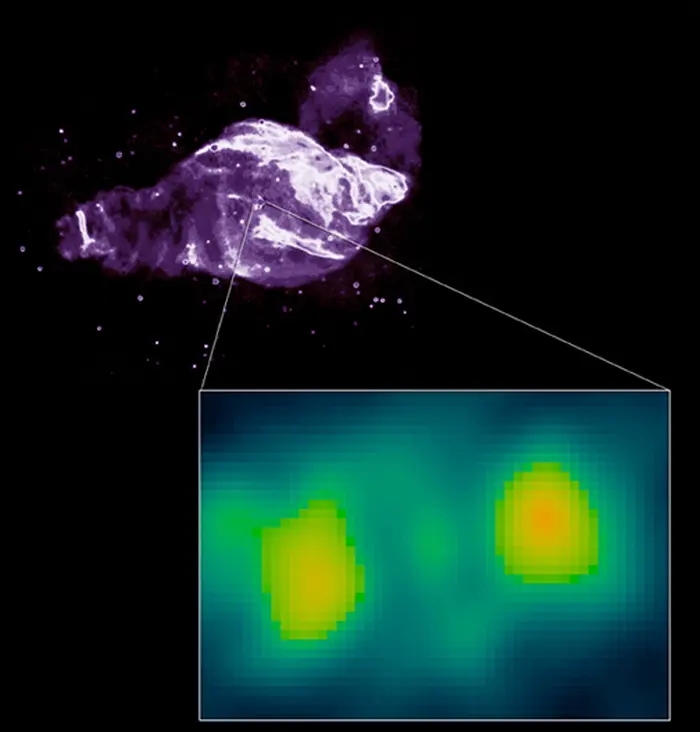
X-ray/Radio Composite of SS 433 In this X-ray/radio composite image, the radio data (upper left) were observed by the VLA and Bonn 100m on August 19, 1996 for about 7 hours (bandwidth = 1465 MHz). The pullout box of the Chandra X-ray data (lower right) shows two high speed lobes of 50 million degree gas 5 trillion kilometers apart on opposite sides of a binary black hole system. Credit – X-ray: NASA/CXC/U.Amsterdam/S.Migliari et al., Radio: G.M. Dubner, et al. (PD)

The SS-433 System (artist’s impression). Credit: ESO (CC BY 4.0)
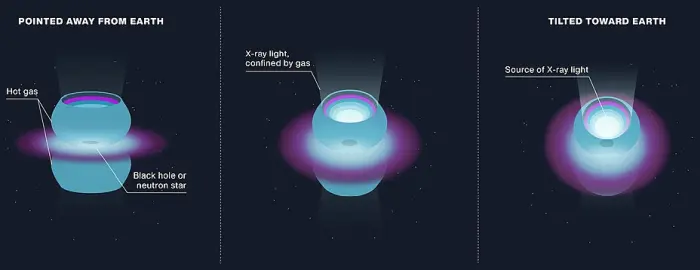
The cosmic object SS 433 contains a bright source of X-ray light surrounded by two hemispheres of hot gas. SS 433 tilts periodically, causing one X-ray beam to point toward Earth. This illustration shows the object known as SS 433, located in the Milky Way galaxy and only about 20,000 light-years from Earth. Researchers think SS 433 is an ultraluminous X-ray source, or ULX, a compact cosmic object that must have an X-ray luminosity that is about a million times the total luminosity output of the Sun (at all wavelengths). ULXs are so bright, they can be seen millions of light-years away, in other galaxies. SS 433 appears to be about 1,000 times dimmer than the minimum threshold to be considered a ULX. This faintness is likely a trick of perspective: The high-energy X-rays from SS 433 are initially confined within two cones of gas extending outward from opposite sides of the central object. These cones are similar to a mirrored bowl that surrounds a flashlight bulb: They corral the X-ray light from SS 433 into a narrow beam, until it escapes and is detected by NuSTAR. But because the cones are not pointing directly at Earth, NuSTAR can’t see the object’s full brightness. Figure 1 illustrates how SS 433 tilts back and forth in its orbit. Its brightness appears to change as it tilts toward and away from Earth. As with a flashlight, SS 433 appears much dimmer when it is viewed from the side. Credit: NASA/JPL-Caltech (PD)